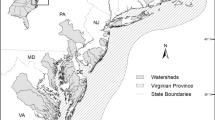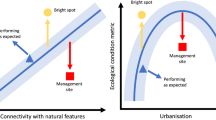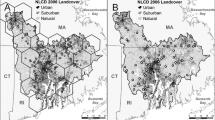Abstract
Land–water interactions were examined in three regions in the Virginian Biogeographic Province; the southern shore of Cape Cod, Massachusetts; the Hudson/Raritan region of New York; and the eastern shore of the Delmarva (Delaware/Maryland/Virginia) Peninsula. Cumulative distribution functions were used to evaluate similarity in environmental condition among estuaries. Spatial-setting variables (location in a river, coastal lagoon, or in open waters) were associated with variation for some measures of estuarine condition. Patterns of coastal urban and agriculture gradients were measured and their relationship with indicators of estuarine condition was modeled statistically. When estuaries were pooled, the highest variation explained by spatial-setting variables was found for dissolved oxygen (DO, R 2 = 0.44) and salinity (R 2 = 0.58), with DO decreasing in river locations and salinity decreasing with rainfall and sampling locations near rivers. The explanatory power for the other indicator variables was low and varied from 6% to 27%. Rainfall explained some of the variation (R 2 = 0.23) in total suspended solids. Moderate (0.4 < | r | < 0.7) to strong (| r | ≥ 0.7) linear associations were found between total urban area and measures of estuarine condition. Within regions, total urban area was positively associated with Silver (r = 0.59), Cadmium (r = 0.65), and Mercury (r = 0.47) in Cape Cod, and inversely related to DO (r = −0.65) in the Hudson/Raritan region. No associations were found in the Delmarva Peninsula study area. Total area of agriculture showed a moderate association with Arsenic in Cape Cod, but no other associations were found in the other two regions. Our analyses show a measurable impact of urban land use on coastal ecosystem condition over large areas of the northeastern United States. This pattern was most evident when many different landscapes were considered simultaneously. The relationship between urban development and estuarine condition were weaker within the individual regions studied. The use of land use/cover models for predicting estuarine condition is a challenging task that warrants enhancements in the type, quantity, and quality of data to improve our ability to discern relationships between anthropogenic activities on land and the condition of coastal environments.




Similar content being viewed by others
References
Anderson DM, Glibert PM, Burkholder JM (2002) Harmful algal blooms and eutrophication: nutrient sources, composition, and consequences. Estuaries 25: 704–726
August PV, Iverson L, Nugranad J (2002) Human conversion of terrestrial habitats. In: Gutzwiller K (ed) Applying landscape ecology in biological conservation. Kluwer Press, New York, USA, pp 198–224
Boyer EW, Goodale CL, Jaworski NA, Howarth RW (2002) Antropogenic nitrogen sources and relationships to riverine nitrogen export in the Northeastern USA. Biogeochemistry 58:137–169
Burroughs RH (1993) Nonpoint sources as external threats to coastal water quality: lessons from park service experience. Coastal Manage 21:131–142
Burroughs RH, Lee V (1991) Cape Cod National Seashore estuaries: guidance for marine environmental monitoring and citizen participation. U.S. Department of the Interior National Park Service, Narragansett, RI
Castro MS, Driscoll CT, Jordan TE, Reay WG, Boyton WR, Seitzinger SP, Styles RV, Cable JE (2001) Contribution of atmospheric deposition to the total nitrogen loads to thirty-four estuaries on the Atlantic and Gulf coasts of the United States. In: Valigura RA et al (eds) Nitrogen loading in coastal water bodies: an atmospheric perspective. AGU, Washington, DC, pp 77–106
Cohen JE (1994) Marine continental food webs: three paradoxes? Phil Trans Roy Soc London B 343:57–69
Comeleo RL, Paul JF, August PV, Copeland J, Baker C, Hale SS, Latimer RW (1996) Relationships between watershed stressors and sediment contamination in Chesapeake Bay estuaries. Landscape Ecol 11:307–319
Conover WJ (1999) Practical nonparametric statistics, 3rd edn. Wiley, New York
Cloern JE (2001) Our evolving conceptual model of the coastal eutrophication model. Marine Ecol Prog Series 210:223–253
Day JW, Hall AS, Kemp WM, Yanez-Arancibia A (1989) Estuarine ecology. Wiley, New York, USA
Dennison WC, Orth RJ, Moore KA, Stevenson JC, Carter V, Kollar S, Bergstrom PW, Batiuk R (1993) Chesapeake Bay submerged aquatic vegetation habitat requirements for a polyhaline environment. Bioscience 43:86–94
Dyer KR (1997) Estuaries: a physical introduction. Wiley, New York
Evgenidou A, Valiela I (2002) Response of growth and density of a population of Geukensia demisa to land-derived nitrogen loading, in Waquoit Bay, Massachusetts. Estuarine Coastal Shelf Sci 55:125–138
Fairbridge R (1980) The estuary: its definition and geodynamic cycle. In: Olausson E, Cato I (eds) Chemistry and biochemistry of estuaries. Wiley, New York, pp 1–35
Fedorko EJ, Pontius RG Jr, Aldrich SP, Claessens L, Hopkinson C Jr, Wollheim WM (2005) Spatial distribution of land type in regression models of pollutant loading. J Spatial Hydrol 5:60–80
Hall SJ, Raffaelli DG, Thrush SF (1994) Patchiness and disturbance in shallow water benthic assemblages. In: Giller PS, Hildrew AG, Raffaelli DG (eds) Aquatic ecology: scale, pattern, and process. Blackwell Science, Oxford, pp 333–375
Hobbie JE (2000) Estuarine science: a synthetic approach to research and practice. Island Press, Washington DC
Hollister JW, Gonzalez ML, Paul JF, August PV, Copeland JL (2004) Assessing the accuracy of the National Land Cover Dataset at multiple spatial extents. Photogram Eng Remote Sensing 70:405–414
Houghton RA (1994) The worldwide extent of land-use. Bioscience 44:305–313
Howarth RW, Sharpely A, Walker D (2002) Sources of nutrient pollution to coastal waters in the United States: implications for achieving coastal water quality goals. Estuaries 25:656–676
Howarth RW, Bllen G, Swaney D, Townsend A, Jaworski N, Lajtha K, Downing JA, Elmgren R, Caraco N, Jordan T, Berendse F, Freney J, Kudeyarov V, Murdoch P, Zhao-Liang Z (1996) Regional nitrogen budgets and riverine N & P fluxes for the drainages to the North Atlantic Ocean: natural and human influences. Biogeochemistry 35:75–139
Kemp WM, Petersen JE, Gardner RH (2001) Scale-dependence and the problem of extrapolation. In: Gardner RH, Kemp WM, Kennedy VS, Petersen JE (eds) Scaling relations in experimental ecology. Columbia University Press, New York, USA, pp 3–57
Kiddon JA, Paul JF, Buffum HW, Strobel CS, Hale SS, Cobb D, Brown BS (2003) Ecological condition of US Mid-Atlantic estuaries, 1997–1998. Marine Pollut Bull 46:1224–1244
Krummel JR, Gardner RH, Sugihara G, O’Neill V (1987) Landscape patterns in a disturbed environment. Oikos 48:321–324
Legendre P, Thrush SF, Cummings VJ, Dayton PK, Grant J, Hewitt JE, Hines AH, McArdle BH, Pridmor RD, Schneider DC, Turner SJ, Whitlach RB, Wilkinson MR (1997) Spatial structure of bivalves in a sandflat: scale and generating processes. J Exp Marine Biol Ecol 216:99–128
Loveland TR, Shaw DM (1996) Multiresolution land characterization: building collaborative partnerships. In: Scott, JM, Tear T, Davis F (eds) Gap analysis: a landscape approach to biodiversity planning. Proccedings of the ASPRS/GAP Symposium Charlotte, NC, National Biological Service, Moscow, ID, pp 83–89
Loveland TR, Merchant JW, Ohlen DO, Brown JF (1991) Development of a landcover characteristics database for the conterminous US. Photogram Eng Remote Sensing 57:1,453–1,463
Malone TC, Conley DJ (1996) Trends in nutrient loading and eutrophication: A comparison of the Chesapeake Bay and the Hudson river estuarine systems. In: Sherman K, Jaworksi NA, Smayda TJ (eds) The northeast shelf ecosystem: assessment, sustainability, and management. Blackwell Science Inc., 238 Main Street Cambridge, MA, 02142 USA, pp 327–349
Mann KH, Lazier JRN (1996) Dynamics of marine ecosystems: biological–physical interactions in the oceans. Blackwell Science Inc., 238 Main Street, Cambridge, MA 02142 USA
Menzie CA, Hoeppner SS, Cura JJ, Freshman JS, LaFrey EN (2002) Urban and suburban storm water runoff as a source of polycyclic aromatic hydrocarbons (PAHs) to Massachusetts estuarine coastal environments. Estuaries 25:165–176
National Coastal Condition Report (NCCR) (2001) (on-line) Report EPA620-R-01-005. Environmental Protection Agency, Office or Research and Development/Office of Water, Washington, DC. http://www.epa.gov/owow/oceans/nccr/index.html
National Park Service (NPS) (2000) The national parks: index 2001–2003: offical index of the national park system. U.S. National Park Service. GPO: 2001-472-468/40002
National Research Council (NRC) (2000) Clean coastal waters: understanding and reducing the effects of nutrient pollution. National Academy Press, Washington, DC
Nixon SW (1995) Coastal marine eutrophication: a definition, social causes, and future concern. Ophelia 41:199–219
O’Connor TP (1996) Coastal sediment contamination in the northeast shelf large marine ecosystem. In: Sherman K, Jaworksi NA, Smayda TJ (eds) The northeast shelf ecosystem: assessment, sustainability, and management. Blackwell Science, 238 Main Street, Cambridge MA, 02142, USA, pp 239–257
O’Shea ML, Brosnan TM (2000) Trends in indicators of eutrophication in Western Long Island Sound and the Hudson–Raritan Estuary. Estuaries 23:877–901
Ott WR (1995) Environmental statistics and data analysis. Lewis Publishers, Boca Raton
Overton WS (1989) Design report of the environmental monitoring and assessment program. U.S. Environmental Protection Agency, Environmental Research Laboratory, Corvallis, OR
Overton WS, White D, Stevens DL (1990) Design report for EMAP: Environmental Monitoring and Assessment Program EPA/600/3–91/053. U.S. Environmental Protection Agency, Office of Research and Development, Washington DC
Paerl HW, Dennis RL, Whitall ER (2002) Atmospheric deposition of nitrogen: implications for nutrient over-enrichment of coastal waters. Estuaries 25:677–693
Paul JF, Comeleo RL, Copeland J (2002) Landscape metrics and sediment contamination in the Mid-Atlantic and Southern New England Region. J Environ Qual 31:836–845
Paul JF, Strobel CJ, Melzian BD, Kiddon JA, Latimer JS, Campbell DE, Cobb DJ (1998) State of the estuaries in the Mid-Atlantic region of the United States. In: Sandhu S, Jackson L, Austin K, Hyland J, Melzian B, Summers K (eds) EPA monitoring ecological condition at regional scales: proceedings of the third symposium on the environmental monitoring and assessment program (EMAP). Kluwer Academic Publishers, Albany, NY, USA, pp 269–284
Paul JF, Gentile JH, Scott KJ, Schimmel C, Campbell DE, Latimer RW (1999) EMAP-Virginian Province four-year assessment report (1990–93). EPA 600/R-99/004. US Environmental Protection Agency, Atlantic Ecology Division, Narragansett, RI, USA
Paul JF, Scott KJ, Campbell DE, Gentile JH, Strobel CS, Valente RM, Wisberg SB, Holland AF, Ranasinghe JA (2001) Developing and applying a benthic index of estuarine condition for the Virginian Biogeographic Province. Ecol Indicators 1:83–99
Portnoy JW, Nowicki BL, Roman CT, Urish DW (1998) The discharge of nitrate-contaminated groundwater from developed shoreline to marsh-fringed estuary. Water Resour Res 34:3095–3104
Price K (1998) A framework for Delaware inland bays environmental classification. In: Sandhu S, Jackson L, Austin K, Hyland J, Melzian B, Summers K (eds) Monitoring ecological condition at regional scales. Proceedings of the Third Symposium on the Environmental Monitoring and Assessment Program (EMAP) Albany, NY, USA, April 8–11. Kluwer Academic Publishers, Boston, USA
Rodriguez W (2003) Remote sensing and landscape analysis of estuarine condition in the Northeastern United States. Ph.D. Dissertation, University of Rhode Island: Kingston, Rhode Island, USA
Roman CT, Jaworski N, Short FT, Findlay S, Warren RS (2000) Estuaries of the Northeastern United States: habitat and land use signatures. Estuaries 23:743–764
Scheffer M, Hosper S, Meijer M-L, Moss B, Jeppesen E (1993) Alternative equilibria in shallow lakes. Trends Ecol Evol 8:275–279
Short FT, Burdick DM (1996) Quantifying eelgrass habitat loss in relation to housing development and nitrogen loading in Waquoit Bay, Massachusetts. Estuaries 19:730–739
Sklar F, Costanza R (1991) The development of dynamic spatial models for landscape ecology: a review and prognosis. In: Turner MG, Gardner RH (eds) Quantitative methods in landscape ecology. Springer-Verlag, New York, USA, pp 239–288
Smirnov NV (1939) Estimate of deviation between empirical distribution functions in two independent samples. (Russian) Bull Moscow Univ 2:3–16
Smith VH (1998) Cultural eutrophication of inland, estuarine, and coastal waters. In: Pace ML, Groffman PM (eds) Successes, limitations and frontiers in ecosystem science. Springer-Verlag, New York, USA, pp 7–49
SPSS, Inc (2006) SPSS for windows, version 14.0, Chicago
Steele JH (1985) A comparison of terrestrial and marine ecological systems. Nature 313:355–358
Steele JH, Henderson EW (1994) Coupling between physical and biological scales. Proc Roy Soc London B 343:5–9
Stevens SM, Milstead B (2002) Northeast coastal and barrier network monitoring plan: Phase I, National Park Service Inventory and Monitoring Program, National Park Service, unpublished Report
Strahler AN (1966) A geologist’s view of Cape Cod. Parnassus Imprints, Orleans, MA
Turner BL II, Skole D, Sanderson S, Fischer G, Fresco LO, Leemans R (1995) Land-use and land-cover change. Science/Research Plan (IGBP Report No. 35, HDP Report No. 7). IGBP of the ICSU and HDP of the ISSC, Stockholm and Geneva
Turner MG (1989) Landscape ecology: the effects of pattern on process. Annu Rev Ecol Syst 20:171–199
U.S. Environmental Protection Agency (USEPA) (1990) Environmental monitoring and assessment program overview EPA/600/9-90/001. US Environmental Protection Agency Office of Research and Development, Washington, DC
U.S. Environmental Protection Agency (USEPA) (1995) Statistical summary EMAP estuaries, Virginian Province, 1993, EPA/620/R-94/026, 86 pages
US Environmental Protection Agency (USEPA). (1996) Final comprehensive conservation and management plan. New York–New Jersey Harbor Estuary, Program Including the Bight Restoration Plan, New York USA
U.S. Environmental Protection Agency (USEPA) (1997) An ecological assessment of the United States Mid-Atlantic region: a landscape atlas. EPA/600/R-97/130, Office of Research and Development, Washington, DC
U.S. Environmental Protection Agency (USEPA) (1998) Condition of the Mid-Atlantic estuaries. EPA 600-R-98-147, Office of Research and Development, Washington, DC
Valiela I (1984) Marine ecological processes. Springer-Verlag, New York, USA
Valiela I, Foreman K, LaMontagne M, Hersh D, Costa J, Peckol P, DeMeo-Anderson B, D’Avanzo C, Babione M, Sham C, Brawley J, Lajtha K (1992) Couplings of watersheds and coastal waters: sources and consequences of nutrient enrichment in Waquoit Bay, Massachusetts. Estuaries 15:443–457
Valiela I (1995) Marine ecological processes. Springer-Verlag, New York, USA
Vitousek PM, Aber JD, Howarth RW, Likens GE, Matson PA, Schindler DW, Schindler WH, Tilman DG (1997) Human alteration of the global nitrogen cycle: sources and consequences. Ecol Appl 7:737–750
Vogelman JE, Wickham JD (2000) Implementation strategy for production of National Land-Cover Data (NLCD) from the Landsat 7 Thematic Mapper Satellite EPA 600/R-00/051 Office of Research and Development. U.S. Environmental Protection Agency, Washington, DC
Vogelman JE, Howard SM, Yang L, Larson CR, Wylie BK, Van Driel N (2001) Completion of the 1990s National Land Cover Data set for the conterminous United States from Landsat Thematic Mapper Data and ancillary data sources. Photogram Eng Remote Sensing 67:650–652
Vollenweider RA, Marchetti R, Viviani R (1992) Marine coastal eutrophication – the response of marine transitional systems to human impact: problems and perspectives for restoration. Proceedings of an International Conference, Bologna, Italy, 21–24 March 1990. Elsevier Science Publishers, Amsterdam, The Netherlands
Wang H, Hondzo M, Xu C, Poole V, Spacie S (2003) Dissolved oxygen dynamics of streams draining an urbanized and an agricultural catchment. Ecol Model 160:145–161
Weisberg SB, Frithsen JB, Holland AF, Paul JF, Scott KJ, Summers JK, Wilson HT, Valente R, Heimbuch DG, Gerritsen J, Schimmel SC, Latimer RW (1992) EMAP-Estuaries Virginian Province 1990 Demonstration Project Report EPA 600/R-92/100. U.S. Environmental Protection Agency, Environmental Research Laboratory, Narraganssett, RI, USA
Wiens JA (1989) Spatial scaling in ecology. Funct Ecol 3:385–397
Yang L, Stehman SV, Smith JH, Wickham JD (2001) Thematic accuracy of MRLC land cover for the Eastern United States. Remote Sensing Environ 76:418–422
Acknowledgments
We thank the North Atlantic Coast Cooperative Ecosystem Study Unit (NAC-CESU) at the University of Rhode Island and the University of Rhode Island Graduate Fellowship Office for partial funding of this research. We also thank Professor J. Heltshe for statistical advice, and the USEPA Atlantic Division in Narragansett, RI for data access. We gratefully acknowledge two anonymous reviewers that suggested changes that substantially improved the original manuscript.
Author information
Authors and Affiliations
Corresponding author
Rights and permissions
About this article
Cite this article
Rodriguez, W., August, P.V., Wang, Y. et al. Empirical relationships between land use/cover and estuarine condition in the Northeastern United States. Landscape Ecol 22, 403–417 (2007). https://doi.org/10.1007/s10980-006-9036-8
Received:
Accepted:
Published:
Issue Date:
DOI: https://doi.org/10.1007/s10980-006-9036-8




